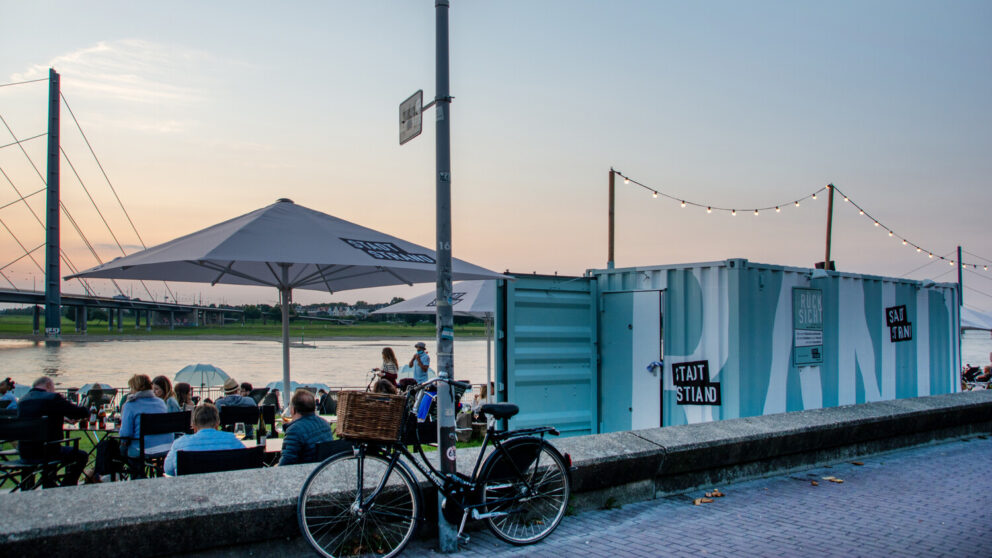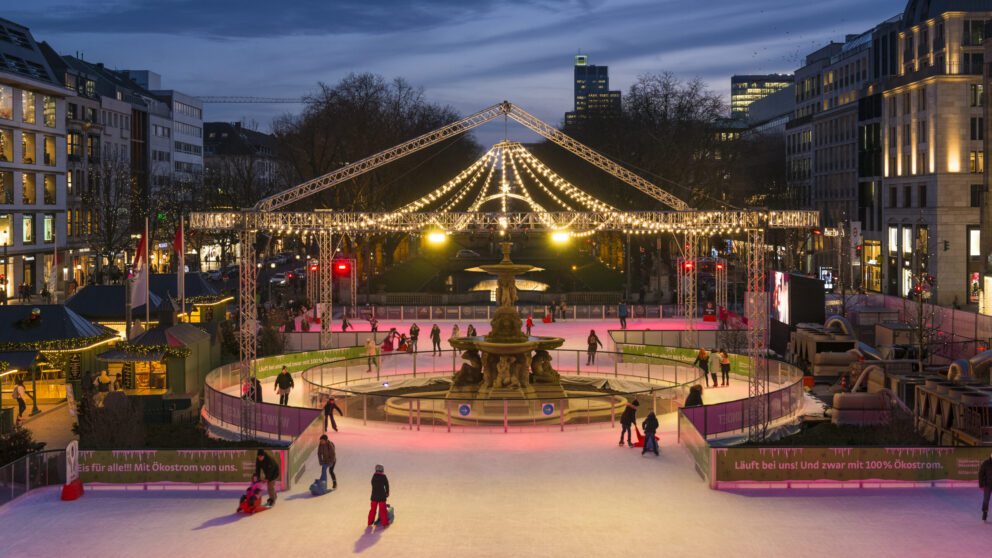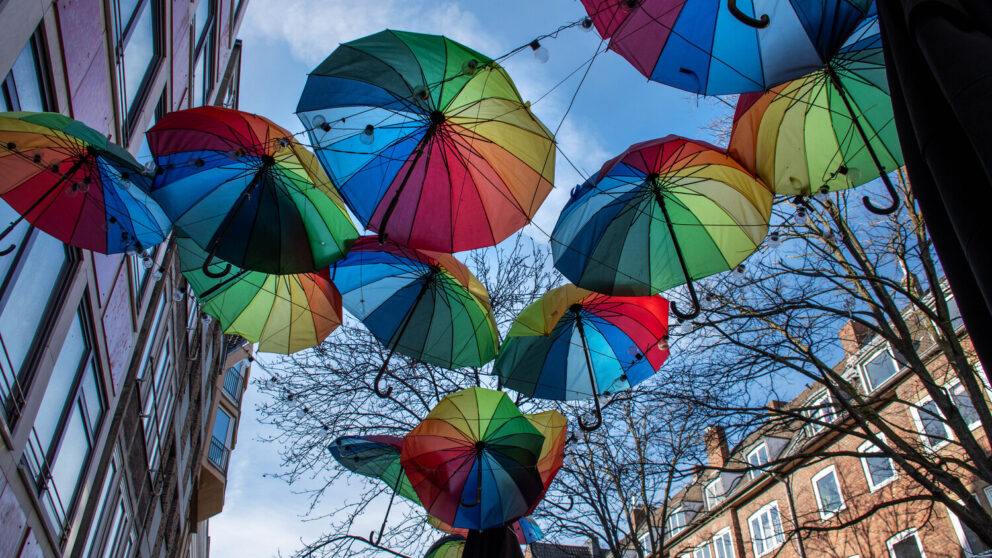
Six wildlife experiences in Düsseldorf
Six wildlife experiences in Düsseldorf
Grab your binoculars and telephoto lenses and let's go on an urban safari!
Wildlife in Düsseldorf?! Yes, exactly! Indeed, the fauna in and around the Rhine metropolis has many unexpected things in store and thus has the potential to fascinate every animal lover - from the amateur ornithologist to the fan of ice-age primordial creatures.
The collared parakeets from the Kö
The vernacular speaks of parrots. In reality, the bright green birds with the coral beaks and long tail feathers are collared parakeets - and they have discovered Düsseldorf's first address for themselves: the Kö. There are said to be over 1,000 of them that regularly use the Kö plane trees as roosting trees. Legend has it that the birds, which are actually native to Asia and Africa, escaped from a Cologne zoo in the late 1960s. But they have long since become true Düsseldorfers who clearly love their city - from Bilk to Kalkum. That doesn't change the exoticism exuded by a flock of collared parakeets as they shoot through the streets at speeds of up to 70 kilometers per hour. The males, by the way, can be recognized by their black neck feather ring, hence the name.
The pond turtles in the South Park
If you're already on your way to Volksgarten with your kids, you can also cycle right through to Südpark and take a look at the pond turtles there - the North American ones, mind you. The European pond turtle, which is native to Germany, has unfortunately dwindled to a small population. The relatives from overseas, also known as ornamental turtles, bask for hours on a small island in the dike lake when the weather is good. It's a funny spectacle to see them all craning their wrinkled necks and gazing up at the sky in unison. Where do they come from? The popular pets are not infrequently abandoned by overburdened owners. In winter, the turtles hibernate, burying themselves on land or in the mud of the lake. Then the turtle safari has to pause.
The stingrays at the Aquazoo
When it comes to the underwater world, the Aquazoo in Düsseldorf outshines the competition. Two species of stingrays make a not insignificant contribution to this. Majestically, the cartilaginous fish with the flat, up to 120 cm wide and two meter long diamond-shaped body draw their circles in the large sea basin. Their fin movement is more reminiscent of a wing beat and evokes associations with an eagle gliding elegantly through the air. You almost have to laugh when the rays behind the glass then turn their bright belly sides toward you: Suddenly you look into a friendly face - two eyes, one mouth. But in reality the eyes of the ray are on the back side, the two dots on the top side are nostrils. In the wild, by the way, this curious fellow is not to be trifled with: All stingrays have a poisonous tail sting.
The Heck Cattle in the Neander Valley
Its history is archaic, its shape imposing. The aurochs, the progenitor of today's domestic cattle, was once the largest land mammal in Europe, measuring up to two meters and weighing a ton. In early modern times, the animal with the enormous horns was wiped out, and the Neanderthal man also hunted the aurochs. It now lives here again as a re-bred, no less impressive Heck cattle: In the Neandertal Ice Age Game Preserve, the cozy primeval beasts are kept outdoors year-round - and sometimes lie down where you can't see them so well. Binoculars are a good idea. Also on the move on the high and valley meadows and the wooded slopes of the site: bison, descendants of another European wild cattle species, and stern horses, a backbred of the extinct wild horse Tarpan. With its 23 hectares, the enclosure can be comfortably walked around in an hour to an hour and a half.
The kingfishers at the swan mirror
The distance from the ice age to the kingfisher is shorter than expected - after all, the Neander Valley and Düsseldorf's city center are only about 20 km apart. Here, of all places, at the Schwanenspiegel and in the Hofgarten, a feathered species has settled that makes the hearts of amateur ornithologists beat faster. The kingfisher is back! The plumage shimmers in azure and cobalt blue, the breast glows in orange. The long, thin beak with which it fishes its prey out of the water is also striking. NABU has estimated that there will be around 15 breeding pairs in Düsseldorf in 2021. Nevertheless, spotting the bird, which is not even the size of a blackbird, requires a little patience, because it is quite shy. But those who wait will be rewarded. Last year, two hundred kingfisher sightings were reported in the city area.
The sea monsters near the Volksgarten
No less than three sea monsters lie in wait for anyone approaching the north entrance to the Volksgarten - father on the left, mother on the right, the offspring in the middle. The trio, predominantly in the primary colors yellow, red, and blue, also affectionately known as the Nessy Family, towers up to eight meters high on Auf'm Hennekamp and was freshly painted in 2021. And although the playful expressiveness does not necessarily suggest it - the Nessys are first and foremost one thing: exhaust pipes of the Düsseldorf sewer system. In 1996, architect Inge Loerke took on their beautification. Through the circularly paved floor, it almost seems as if the three meandering steel bodies emerged straight from the floods. Children heading towards the Volksgarten on their running bikes or bicycles like to use the canal aeration sculpture as a tunnel course. Wild everyday art with the necessary street credibility.
Title image: Düsseldorf Tourism




